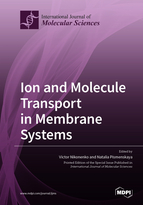Ion and Molecule Transport in Membrane Systems
A special issue of International Journal of Molecular Sciences (ISSN 1422-0067). This special issue belongs to the section "Physical Chemistry and Chemical Physics".
Deadline for manuscript submissions: closed (30 October 2019) | Viewed by 77189
Special Issue Editor
Interests: ion-exchange membranes; structure-property relationships; transport phenomena; experiment; modelling
Special Issues, Collections and Topics in MDPI journals
Special Issue Information
Dear Colleagues,
The scope of this Special Issue involves a large number of topics in the field of membrane science. We welcome papers reporting: Experimental studies and mathematical modeling providing new knowledge on the mechanisms of ion and molecule transport in artificial and living systems; The description of ion and molecule transport through all kinds of membranes, biological and artificial ones; Similarities in behavior of biological and artificial membranes; Biomimetic structural features of artificial membranes and their impact on membrane properties and performance for separation processes; Generalities and case studies in the field of material structure–properties relationships; Physico-chemical and chemico-physical aspects of ion and molecule transport; Thermodynamics and irreversible thermodynamics description; Equilibriums and kinetics of transport processes in membrane systems; Coupling of ion and molecule transport with chemical reactions and catalysis; Impact of forced and natural convection on ion and molecule transport; The mechanisms of electric current-induced convection and its impact on ion and molecule transport across membranes; Concentration polarization and coupled effects occurring in membrane systems under the action of external pressure and electric driving forces (external pressure and electric potential gradients applied to a membrane); The physico-chemical and chemico-physical aspects of transport, separation, purification, and fractionation of organic acids, bioactive compounds, ampholytes, nutrients in membrane systems.
Prof. Dr. Victor V. Nikonenko
Guest Editor
Manuscript Submission Information
Manuscripts should be submitted online at www.mdpi.com by registering and logging in to this website. Once you are registered, click here to go to the submission form. Manuscripts can be submitted until the deadline. All submissions that pass pre-check are peer-reviewed. Accepted papers will be published continuously in the journal (as soon as accepted) and will be listed together on the special issue website. Research articles, review articles as well as short communications are invited. For planned papers, a title and short abstract (about 100 words) can be sent to the Editorial Office for announcement on this website.
Submitted manuscripts should not have been published previously, nor be under consideration for publication elsewhere (except conference proceedings papers). All manuscripts are thoroughly refereed through a single-blind peer-review process. A guide for authors and other relevant information for submission of manuscripts is available on the Instructions for Authors page. International Journal of Molecular Sciences is an international peer-reviewed open access semimonthly journal published by MDPI.
Please visit the Instructions for Authors page before submitting a manuscript. There is an Article Processing Charge (APC) for publication in this open access journal. For details about the APC please see here. Submitted papers should be well formatted and use good English. Authors may use MDPI's English editing service prior to publication or during author revisions.
Keywords
- ion and molecular transport
- physical chemistry
- chemical physics
- transport mechanisms
- living systems
- biological and artificial membranes
- biomimetic structure
- structure–property relationships
- thermodynamics
- irreversible thermodynamics
- equilibriums
- kinetics
- catalysis
- organic acids
- bioactive compounds
- ampholytes
- nutrients
- separation
Related Special Issues
- Ion and Molecule Transport in Membrane Systems 2.0 in International Journal of Molecular Sciences (19 articles)
- Ion and Molecule Transport in Membrane Systems 3.0 in International Journal of Molecular Sciences (14 articles)
- Ion and Molecule Transport in Membrane Systems 4.0 in International Journal of Molecular Sciences (7 articles)
- Ion and Molecule Transport in Membrane Systems 5.0 in International Journal of Molecular Sciences (4 articles)







